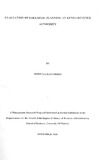| dc.description.abstract | All organizations are faced with challenges of strategic planning. Some from a desire to
grasp new opportunities, and others to overcome significant problems (Johnson and
Scholes, 2002). Strategy is a company’s “game plan”, it does provide a framework for
managerial decisions. It reflects a company’s awareness of how, when, and where it
should compete; against whom it should compete; and for what purpose it should
compete. Strategic planning components are linked together providing managers with a
systematic method for formulating, selecting, implementing and evaluating strategies.
The purpose of this study was to establish the effectiveness of strategic planning at Kenya Revenue Authority. The study was based on the following objectives; to establish
whether Kenya Revenue Authority has met its strategic goals or objectives as stated in
the strategic plans; to establish factors that influence implementation of Kenya Revenue
Authority’s strategic plans and; to establish whether and how Kenya Revenue Authority
carries out monitoring and evaluation of its strategic plans.
To meet the objectives of the study, case study design was adopted. The respondents
were selected from the Top Management and the Research and Corporate planning
section. Primary data was collected using an interview guide while secondary data was
collected from strategic plans and annual reports. In data analysis, content analysis
technique was used. The findings emerging the study concluded that KRA has met most of its strategic goals and objectives across the three strategic plans. Also the
implementation of Kenya Revenue Authority’s strategic plans has been influenced by
various factors which include external and internal factors and that KRA carries out
monitoring and evaluation of its strategic plans.On limitations, this study relied on self-reported and reflective recollection of the indicators of the constructs in this study by employees who volunteered their participation. Because of the perceptual nature of the data, there is the possibility of a percept-percept bias. Second, this study confines itself to a case study method, which leaves room for speculation with regard to causality among the variables. In addition, the sample of this study, consisting mostly of highly educated managers, is likely restricted to a certain group with similar demographic characteristics. Further, the sample size used in the study could be considered to be not representative enough.To increase generalization of this study, more studies in various industries representing diverse demographic cohorts are needed. More specific, this study focused on knowledge workers with a higher educational level. The results might vary by the cohorts in different educational levels. More research in different educational backgrounds is recommended.
The study recommended more longitudinal studies with comparison groups, so that
causality can be fully established. | en |

